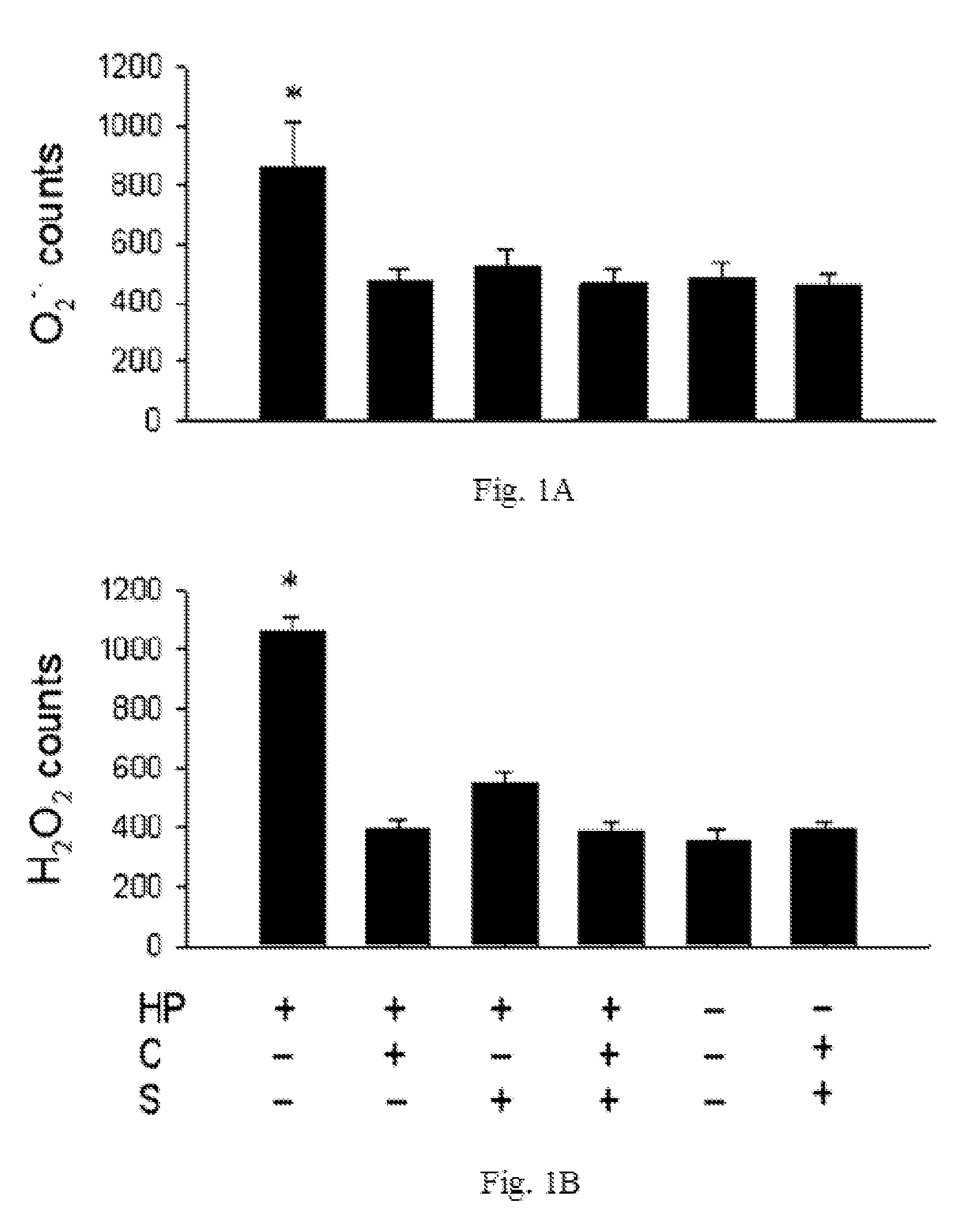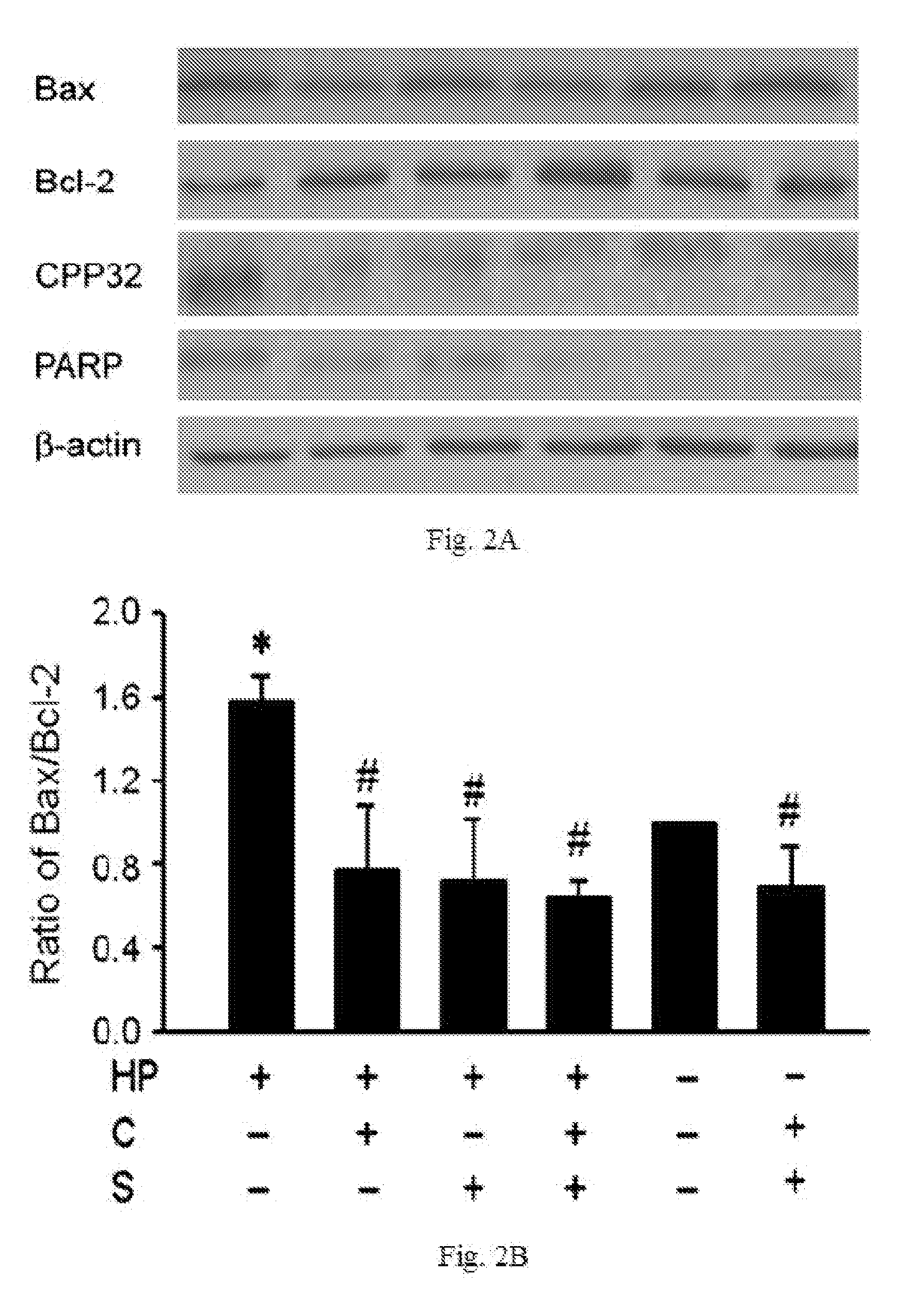Composition for the prevention and the treatment of helicobacter pylori infection
a technology of helicobacter pylori and composition, which is applied in the field of non-antibiotic composition, can solve the problems of inability to completely eradicate helicobacter pylori infection in infected mice, so as to reduce the expression of inducible nitric oxide synthase, the production of o2
- Summary
- Abstract
- Description
- Claims
- Application Information
AI Technical Summary
Benefits of technology
Problems solved by technology
Method used
Image
Examples
example 1
In Vitro Inhibitory Effects Toward Helicobacter pylori of Individual Catechins and Sialic Acid
[0030]The Helicobacter pylori inhibitory effects of catechins and sialic acid were tested in vitro. Twenty Helicobacter pylori strains to be tested were stored at −80° C. and recovered at 37° C. for 3 day under microaerophilic conditions (5% O2, 10% CO2, 85% N2), then resuspended in 10 ml of Brucella broth for 24 h until an optical density at 450 nm of 0.5 units (corresponding to a concentration of 109 CFU (colony-forming units) / L) was reached respectively. The minimal inhibitory concentrations (MIC) of catechins and sialic acid were determined by the agar dilution method. The effect of catechin and sialic acid combination was determined by the checkerboard method and evaluated using the fractional inhibitory concentration (FIC) index.
[0031]Referring to Table 1, the Helicobacter pylori inhibitory effects of catechins and sialic acid were shown in vitro. The MIC was determined as described p...
example 2
In Vitro Inhibitory Effects Toward Helicobacter pylori of Combined Catechins and Sialic Acid
[0032]Inhibitory effects toward twenty Helicobacter pylori strains were similarly tested with combined catechins and sialic acid in vitro. The results are shown in Table 2. The FIC was determined as described previously. All clinical isolates were susceptible to the combination of catechins and sialic acid, which had either an additive or a synergistic effect (Table 2). These data show that sialic acid enhanced the antibacterial activity of catechins. The checkerboard study (data not shown) demonstrated that the combination of 128 mg / L catechins and 32 mg / L sialic acid completely inhibited the growth of all clinical isolates tested in vitro. Antibiotic-sensitive and -resistant isolates did not differ in susceptibility to the combination of catechins and sialic acid.
TABLE 2AdditiveStrainsSynergestic0.5 IndifferentAntagonisticIsolates(n)FIC ≦ 0.5FIC ≦ 11 FIC ≧ 2S104600R103700* S, antibiotic-sen...
example 3
The Oxidative Stress of Helicobacter pylori Infected Human Gastric Cancer Cells (AGS) Was Decreased after Catechins and Sialic Acid Treatment
1. Cell Culture
[0033]A cytotoxin-associated gene A- / vacuolating cytotoxin A-positive strain of Helicobacter pylori (TA1) was recovered from frozen stock by seeding on Columbia agar plate containing 5% sheep blood at 37° C. for 3 day under microaerophilic conditions. The human gastric cancer cell line ATCC CRL 1739 (AGS cells) was cultured in RPMI 1640 medium (Invitrogen) supplemented with 10% fetal bovine serum. For coculture of Helicobacter pylori and AGS cells, the bacteria were resuspended in PBS to 1.0 units at OD 450 nm, corresponding to a bacterial concentration of 2×1011 CFU / L, and added to wells containing Helicobacter pylori and AGS cells to a ratio of 100:1. They were then cocultured for 4 h in the absence or presence of 128 mg / L of catechins and / or 32 mg / L of sialic acid.
2. Oxidative Stress Measurement.
[0034]The nitric oxide (NO) con...
PUM
| Property | Measurement | Unit |
|---|---|---|
| optical density | aaaaa | aaaaa |
| pH | aaaaa | aaaaa |
| antioxidant activity | aaaaa | aaaaa |
Abstract
Description
Claims
Application Information
 Login to View More
Login to View More - R&D
- Intellectual Property
- Life Sciences
- Materials
- Tech Scout
- Unparalleled Data Quality
- Higher Quality Content
- 60% Fewer Hallucinations
Browse by: Latest US Patents, China's latest patents, Technical Efficacy Thesaurus, Application Domain, Technology Topic, Popular Technical Reports.
© 2025 PatSnap. All rights reserved.Legal|Privacy policy|Modern Slavery Act Transparency Statement|Sitemap|About US| Contact US: help@patsnap.com



